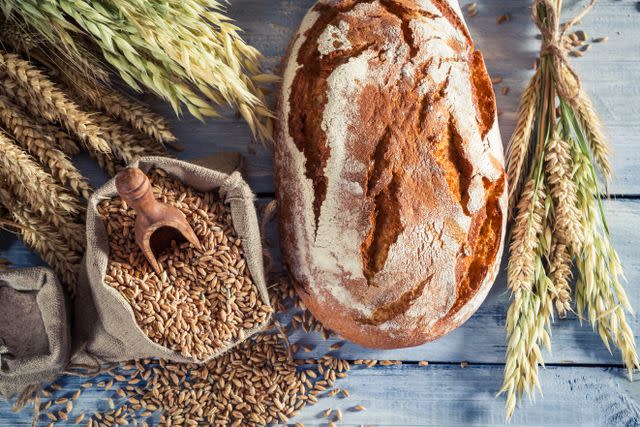Is Wheat Bread Healthy?
Should you pass on the bread basket—or dig right in?
Whether you're all-in on a Sunday morning French toast or want a crusty loaf to serve with pasta, odds are bread shows up regularly in your meals. But all breads aren't created equal—and some are healthier than others.
Related: These Are the 6 Healthiest Bread Options Out There, According to RDNs
Here's everything you need to know to answer the question, "is whole wheat healthy?"—and how to choose the healthiest breads possible to enjoy.

Gabi Musat/Getty Images
What's the difference between whole wheat bread and white bread?
While both whole wheat bread and white bread are made with wheat flour, there's a difference in the makeup of the flour that's used for the bread.
The flour used for white bread (and even some wheat breads) is refined, removing some healthy parts of the wheat kernel. The bran (which has a ton of fiber) and the germ (which contains plenty of nutrients) are removed and the starchy endosperm is all that's left.
Related: What's the Difference Between Whole Wheat, Whole Grain, and Multigrain Bread?
Whole wheat flour is made of the whole kernel, including both the bran and the germ, which produces a more hearty and nutrient-rich flour for bread, pasta, and baked goods.
Health benefits of whole wheat bread
While whole wheat bread may not pack the same nutritional punch of a superfood, it's still offers plenty of healthy benefits if you eat it—especially if you replace more refined baked goods with these whole grain options.
Wheat bread is higher in fiber
No surprise that a whole wheat bread would offer plenty of fiber, given that the wheat brain remains as part of the flour. Generally, a slice of white bread provides less than a gram of fiber, while you'll find wheat breads with up to four grams of fiber in each slice. (That'll put you much closer to the 25 to 30 gram fiber goal for your daily diet.)
Related: This Is How Much Fiber You Really Need a Day—and How to Eat Enough of It
Wheat bread has more of certain nutrients
Whole wheat flour features nutrients you won't find in refined white flours—unless they've been enriched to add those vitamins and minerals back in. You'll see higher levels of magnesium, selenium, and folate in whole wheat bread.
Wheat bread has more protein
Whole wheat bread contains 25 percent more protein than white bread—which can help slow digestion in addition to providing a building block for improving muscle mass.
Whole grains can be key to an anti-inflammatory diet
Eating whole grain foods can be a key to reducing inflammation in the body. Studies have found that adding whole grain foods to your diet can significantly reduce inflammatory markers—especially among those with pre-existing conditions.
Related: How to Start Eating More Anti-Inflammatory Foods—and Why It's So Important
Whole grains can help regulate blood sugar levels
Whole wheat bread contains complex carbohydrates that take longer for your body to process, and don't result in the blood sugar spikes and crashes that you get with refined carbs.
Whole wheat bread can help reduce the risk of cardiovascular disease
Eating more whole grain foods like whole wheat bread can help reduce your risk of cardiovascular diseases, such as heart attacks and strokes, especially in older adults. (You may be able to thank those anti-inflammatory qualities.)
Watch out for wheat bread if you have certain medical conditions
While wheat bread is pretty healthy, that's definitely not the case if you have certain digestive conditions, such as celiac disease, gluten sensitivity or allergies, or irritable bowel syndrome. In those cases, whole wheat bread could trigger symptoms, such as diarrhea or constipation, abdominal pain, bloating, and gas.
Related: Do Food Sensitivity Tests Work? Here's What Health Experts Say
How to tell if you're getting whole wheat bread
You'll want to look for the word "whole" in the ingredient list (i.e. whole wheat flour). Another easy sign? Look for a whole grain stamp on the packaging, which indicates that the product contains whole grain—either a 50%-plus stamp for products that contain at least half of a serving of whole grains in each serving, or a 100% stamp for products that contain a full whole grain serving.
Your best bet is to look for wheat bread that indicate the amount of whole grain—such as 100 percent whole grains—vs. those that say that simply say it contains whole grains. And look for whole wheat or whole grains to be named at the top of the ingredient list, not below refined or white flour.
For more Real Simple news, make sure to sign up for our newsletter!
Read the original article on Real Simple.

